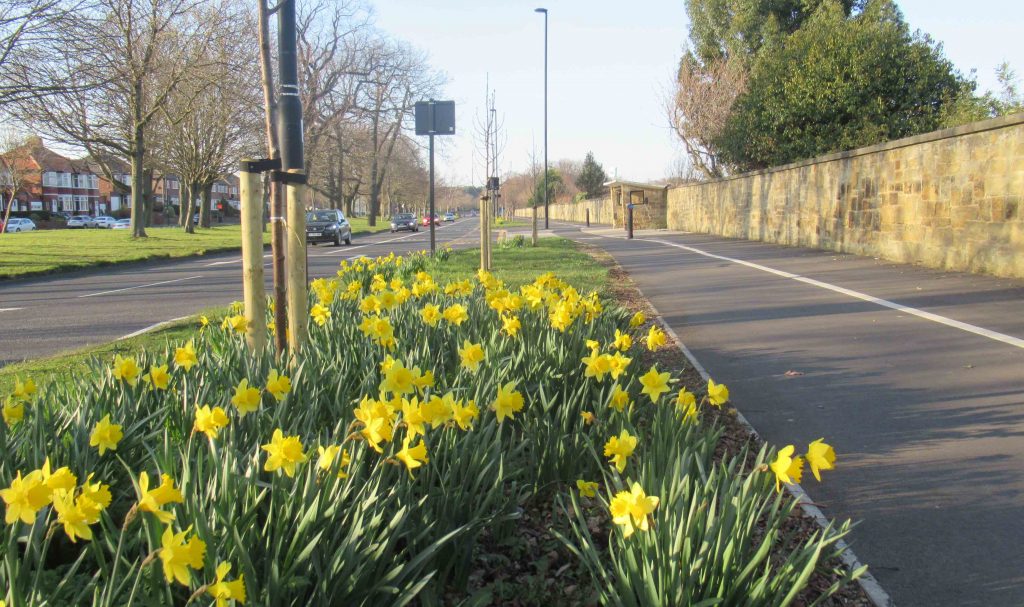
It took the best part of four years but the Broadway to Brunton Lane cycle lanes and new pedestrian crossings have now been completed.
In December 2015, responding to the Council’s initial consultation, we said “Currently this is a busy dual carriageway with frequent busses and fast-moving traffic: it is hard for pedestrians to cross and is largely unsuited to all but the bravest of cyclists.”
Now crossing is easier and local residents can cycle safely in relative comfort along this stretch of road, and it is now one of the few places in Newcastle where it is possible to cycle safely along a main road. The route has even won an award for being the CIHT North East & Cumbria Sustainability Project of The Year. It is undoubtedly a significant step forward in creating a Safe Pedestrian And Cycling Environment for Gosforth.
In the current COVID-19 pandemic, it also allows people to use a cycle to exercise or go to local shops, and the cycle lane can also be used by people walking if they need to pass others while keeping 2m distance. The Government is suggesting workers should walk or cycle more as restrictions start to be eased so it will help that as well.
That said, we should always look to see where the design could have been better or more consistent so it can be improved on in future plans. If the Council wants Newcastle to be “one of the easiest, greenest and safest cities to get around” it still has a way to go to beat the likes of Amsterdam or Copenhagen, but this is definitely a step in the right direction.
We have included some examples at the end of the blog to show how streets have been laid out in similar locations in the Netherlands.
Route Review – North Bound
The new route starts at Broadway Roundabout connecting to the previously installed Regent Centre to Broadway Roundabout cycle lanes. That previous scheme has people walking and cycling sharing the same space by the roundabout but that ends at the start of the new route, marked with a bollard.
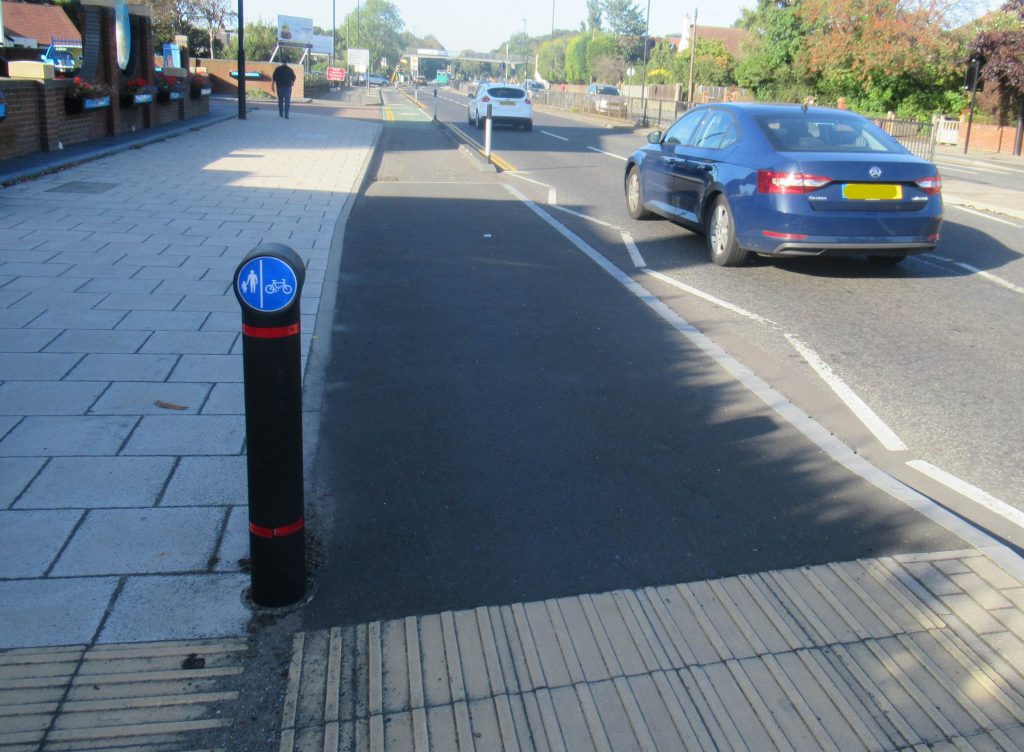
N1 Transition from Broadway Roundabout
For the first part of the cycle lane, the Council have used bolt-down kerbs keeping the cycle lane at road level. The picture below shows the cycle lane still uses less space than the pavement or either of the two road lanes, and possibly also less than the central median.
We understand the original plan was to have the route at pavement height but this approach was adopted to avoid complications with having to reroute utilities under the road.
The bolt-down kerbs don’t provide a lot of separation from traffic but are relatively comfortable and a good bit better than the Orcas used further south. Bolt-down kerbs are also a cheap and quick way of introducing cycle routes. In our response to Newcastle City Council’s Call for Evidence on Climate Change we recommended bolt-down kerbs as one of our “Quick Wins” to enable people to cycle safely within the city.
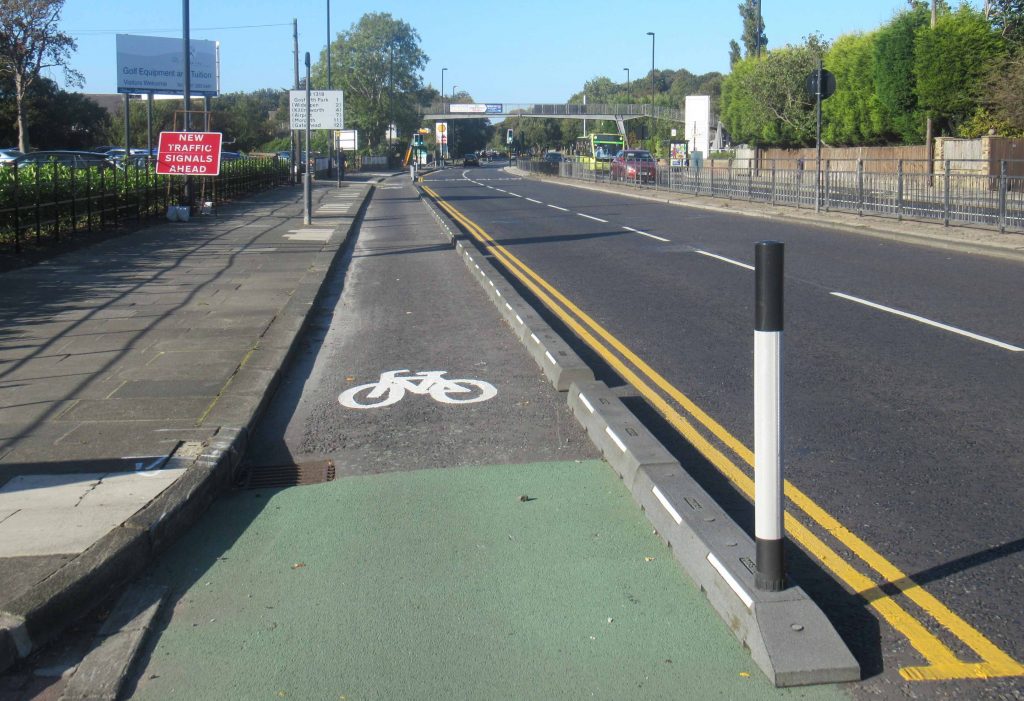
N2 By the City of Newcastle Golf Club
At the next junction, green tarmac is used to show the cycle lane continues across the entrance to the golf club, so traffic into or out of the club has to wait for people cycling along the main road to pass. The end of the bolt-down kerbs is marked by a black and white ‘wand’ and stops relatively close to the entrance so vehicles don’t encroach into the cycle lane and have to slow before turning.
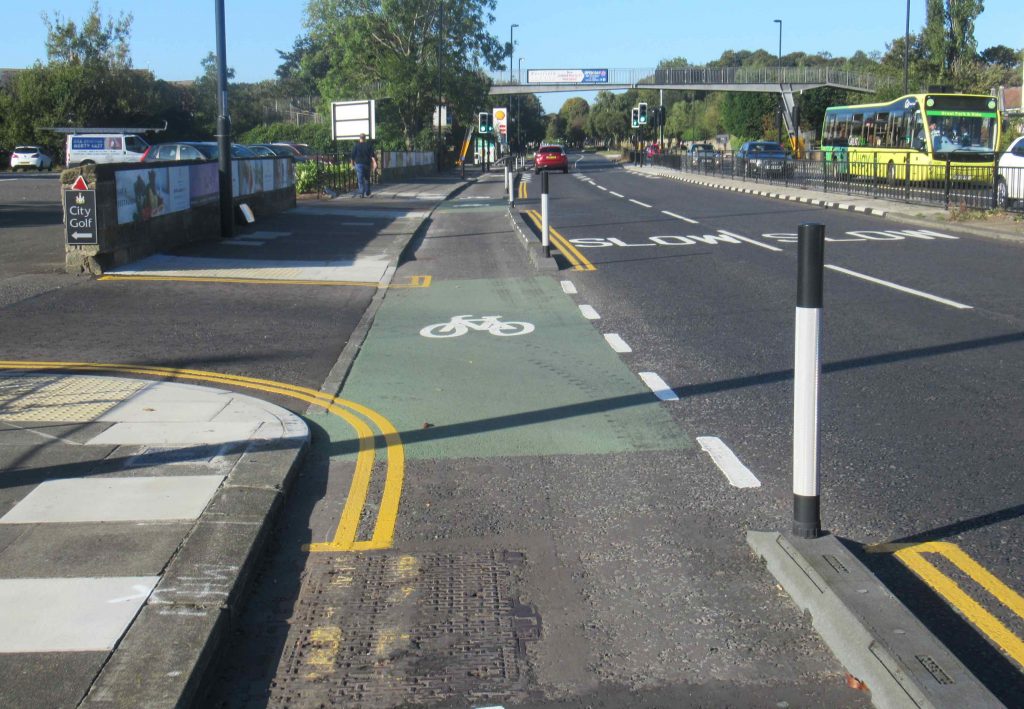
N3 Green tarmac crossing the Golf Club entrance
A new crossing has been installed by the Three-Mile footbridge, This was proposed to help people cross who couldn’t use the footbridge and was subject to a separate consultation.
Although some people think footbridges are safer, there is a body of evidence that suggests the opposite because they encourage drivers to go faster, which means that when collisions do happen they are more serious. See for example this article from the Institute of Transportation and Development Policy (ITDP): Pedestrian Bridges Make Cities Less Walkable. Why Do Cities Keep Building Them?
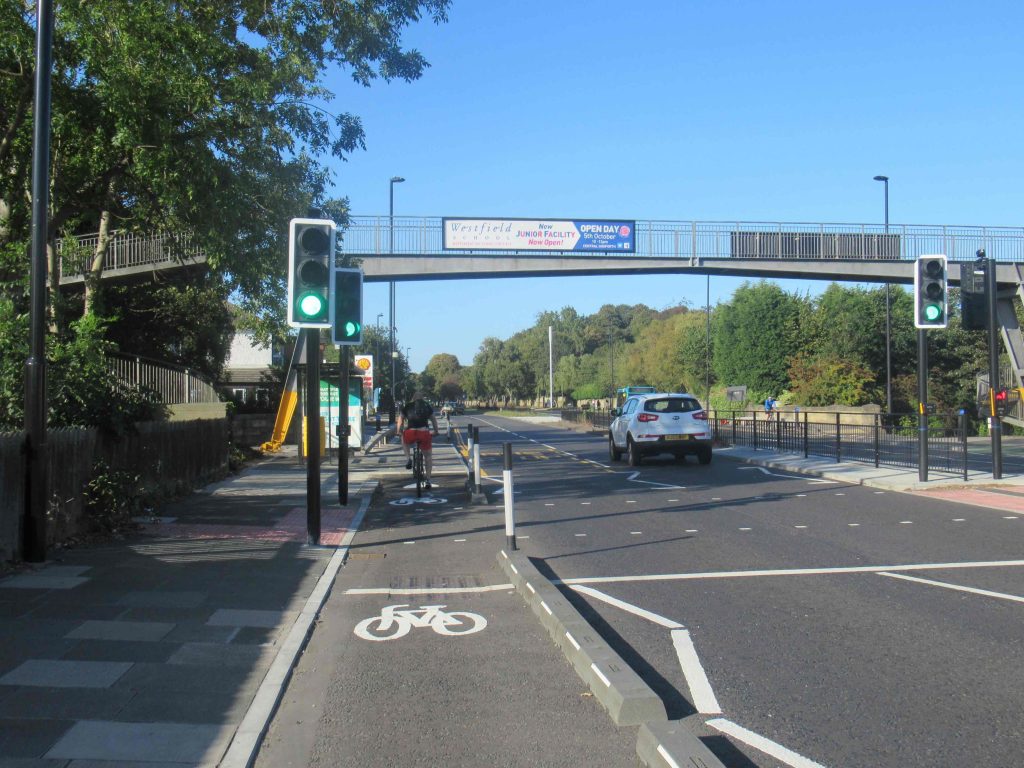
N4 Pedestrian crossing and footbridge by the Three Mile Inn
As the cycle lane is part of the road, people cycling northbound are expected to stop when the pedestrian crossing traffic lights turn red.
At the bus stop next to the bridge, the cycle lane temporarily goes back up to pavement height and passes in front of the bus shelter. The bus shelter was previously blocking the pavement, but has now been moved so people can walk past.
Usually there would be a separate space for people waiting for buses to stand next to the road (on the right of the cycle lane in the picture below) and this was the initial plan before the Council decided to retain the footbridge. Not having this extra space means there is a greater chance of conflict between people cycling and people getting on or off the bus.
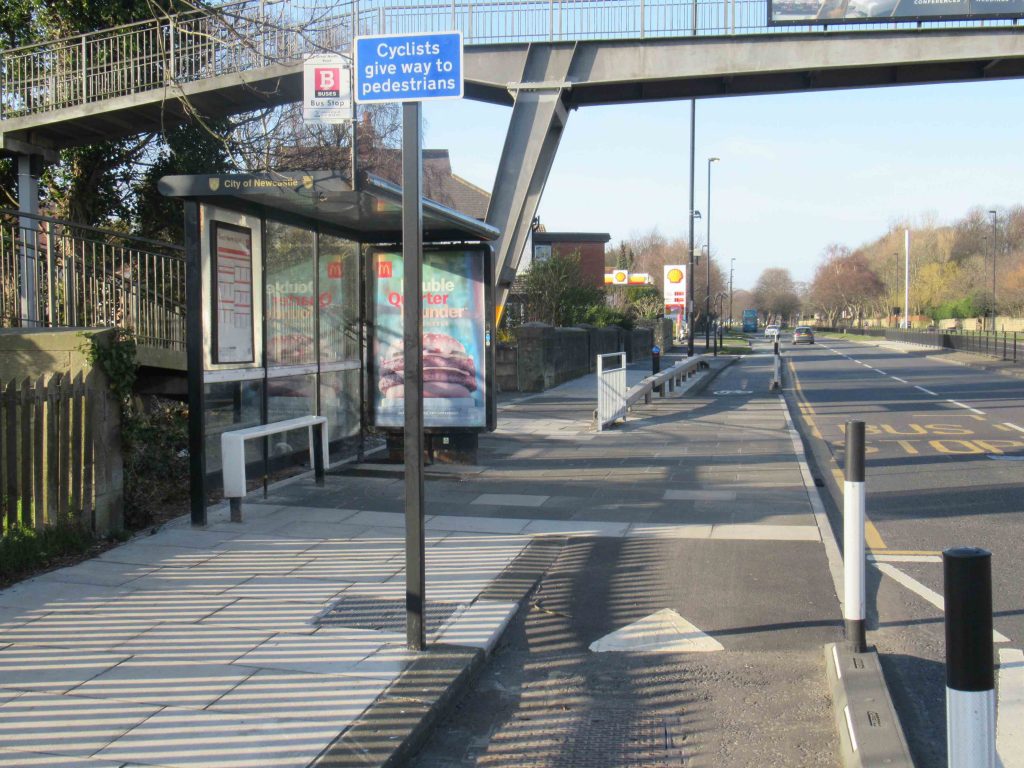
N5 Bus stop opposite the Three Mile Inn
In the picture above you can also see a motorway-style crash barrier after the bus stop. This is to stop motor vehicles mounting the pavement and damaging the bridge and isn’t anything to do with the cycle lane.
At the entrance to Bridge Park, the same green tarmac has been used to show the cycle lane has priority over the side road. This is consistent along the length of the route, although in some cases the give way lines also give priority to pedestrians crossing the side road, but not here for some reason.
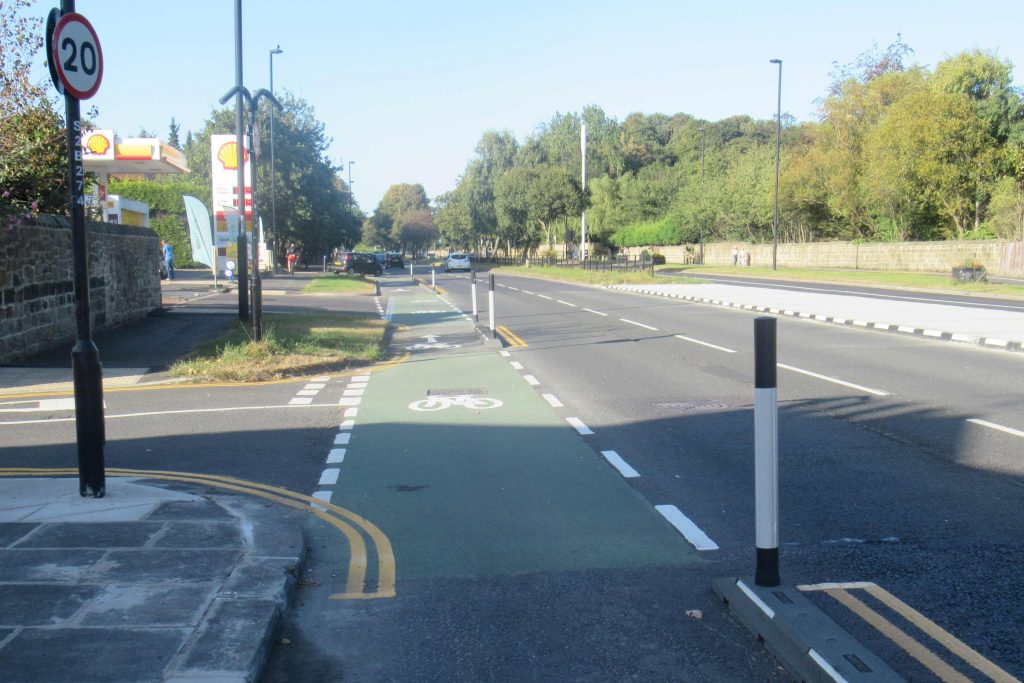
N6 Entrance to Bridge Park
Unlike the green tarmac, the way the double-yellow lines have been drawn does seem to vary between junctions. In the picture above, for example, the lines on the main road and on the corner are separate but in the picture below on the far side of the crossing the lines are continuous. This is more a curiosity though than an issue with the cycle lane.
We’re also unsure why there is only a single dashed line across the exit to the petrol station rather than a double line, which you would expect to show vehicles should give way.
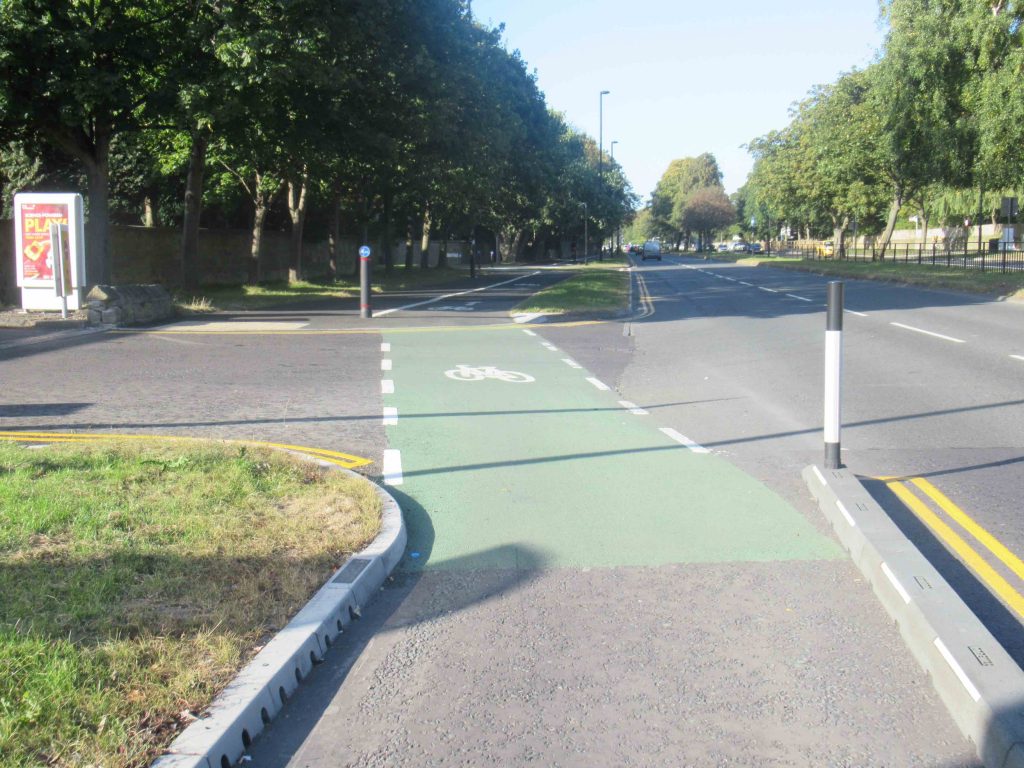
N7 Petrol station exit
After the petrol station the route transitions up to pavement level and stays that way until Polwarth Drive roundabout. Rather than being separated by a kerb, the Council has used a raised white line to mark the boundary between the footway and cycle lane. This is fairly common, partly because it is easy to install, and no doubt also because it is cheaper than installing separate paths or kerb-separation. It also compensates to some extent for narrower cycle lanes or pavements as people cycling can use the footway to overtake and vice-versa.
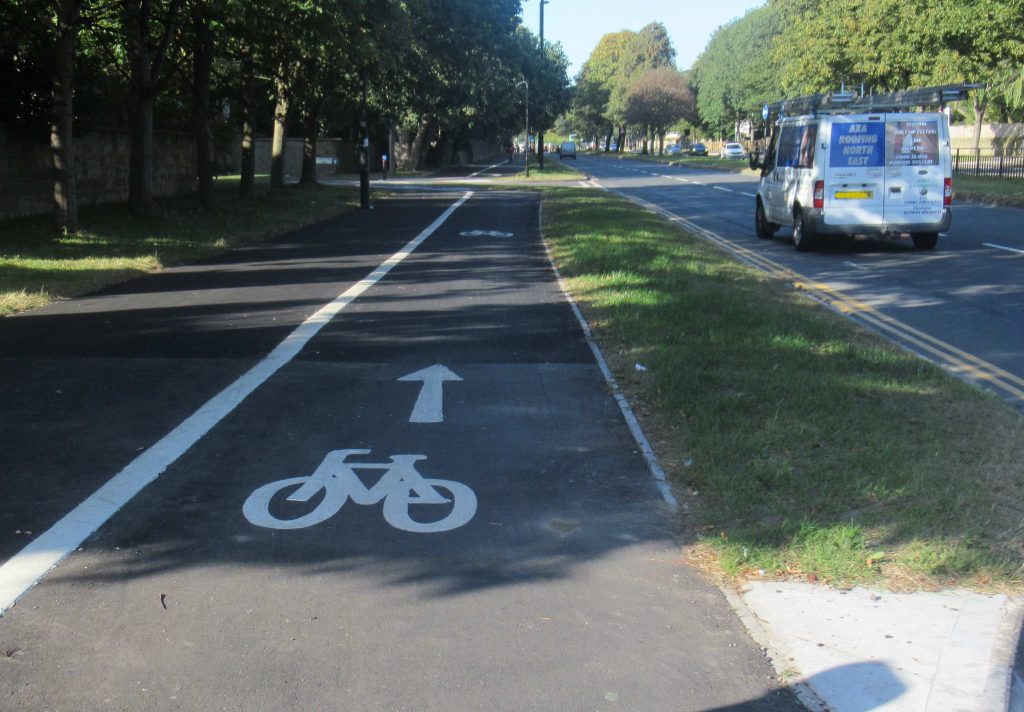
N8 Cycle lane next to Greystoke Park
At Greystoke Park, there used to be a slip road that allowed traffic to exit the Great North Road without slowing. This has been replaced as retaining it would have created unnecessary risks for people crossing the road on foot or cycling.
When vehicles turn into Greystoke Park now they need to slow down in advance of turning and, if someone is crossing the road, there is space to wait off the Great North Road. Unlike at Bridge Park, the give way lines on exiting Greystoke Park also give priority to people crossing the road on foot. A raised crossing also helps to slow vehicles and means that people crossing can do so at the same level.
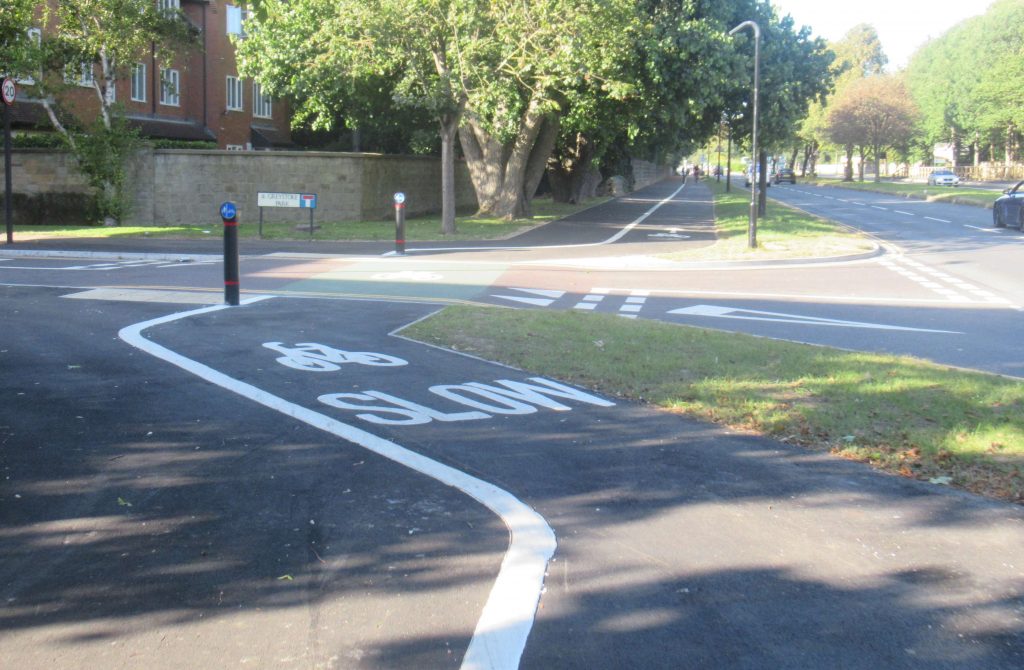
N9 Entrance to Greystoke Park
At Fencer Hill Park (picture below), there isn’t space for the cycle path to bend away from the road so it continues in a straight line across the junction. Perhaps for future schemes the Council might consider making the footway and cycle path fully continuous across junctions as in the Dutch example at the end of this blog.
New tactile paving has been installed at this crossing as well as on other side road crossings along this route. This helps people with a visual impairment know that they are about to cross a road.
Designing for people with a visual impairment is important for any community, but is especially so for Gosforth as the city’s Visual Impairment Additionally Resourced Centre is based at Gosforth Academy.
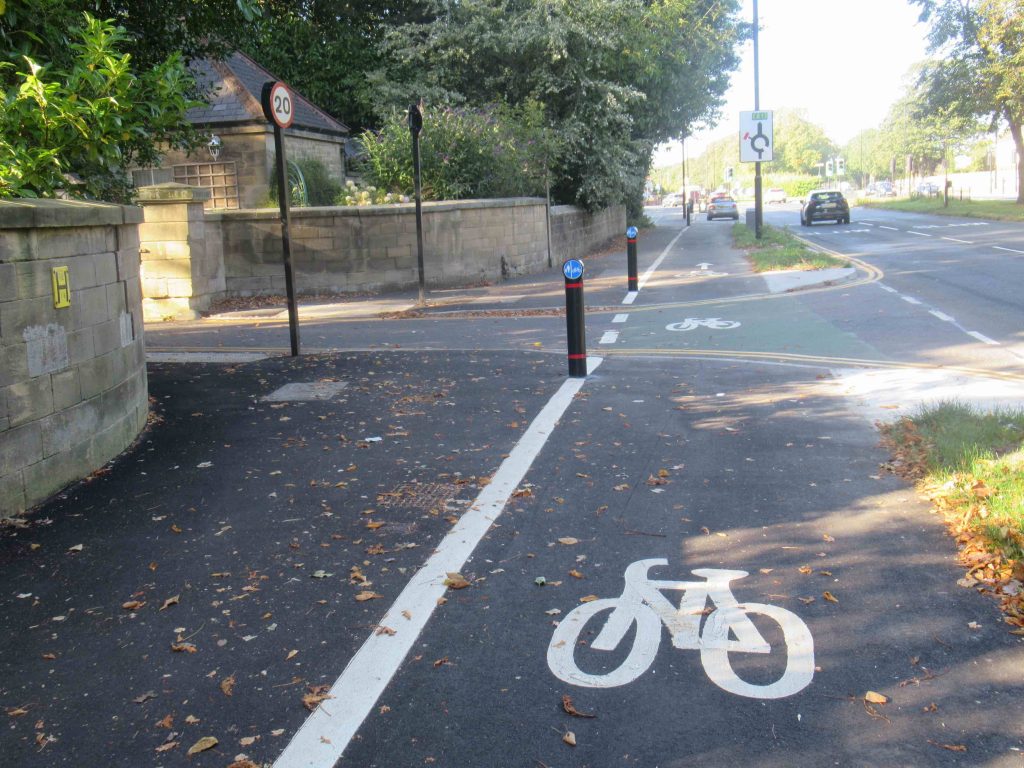
N10 Entrance to Fencer Hill Park
Just before the Polwarth Drive roundabout, the pavement and cycle lane bend away from the road to create additional spaces for residents to park their cars next to the road.
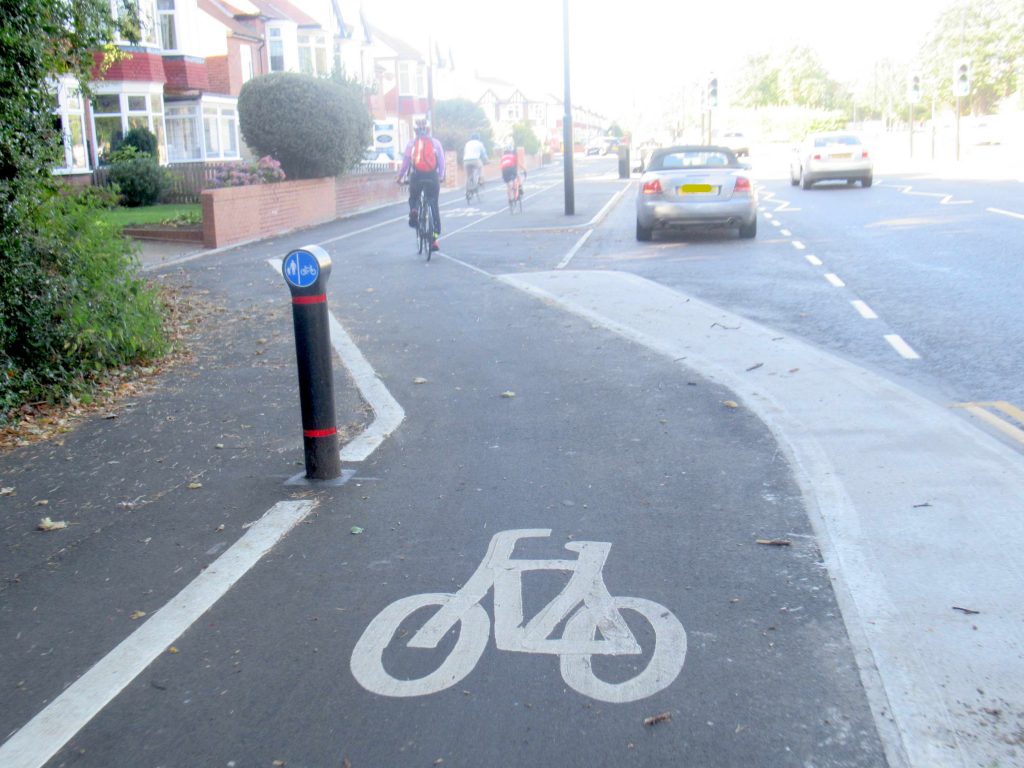
N11 The approach to Polwarth Drive roundabout
At the crossing there is a give-way and slow sign for people heading north. We aren’t sure why priority has been given to people crossing rather than those travelling north. This is the equivalent situation to if a side road had been given priority over The Great North Road, and traffic travelling along the main road had to slow and give way to cars exiting the side roads. Again, it is unlikely to prove a major issue.
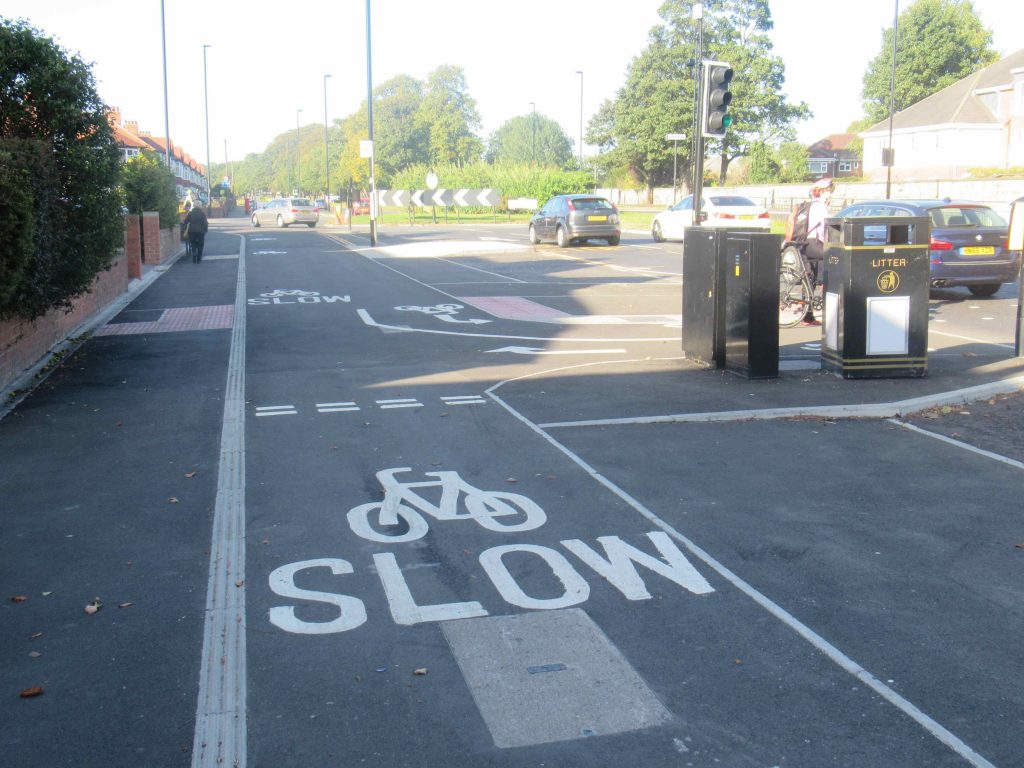
N12 Approaching the pedestrian and cycle crossing
This crossing is the only one on the route where there are separate walking and cycling paths. All the others have shared paths for people walking and cycling. Tactile paving is used to mark the edge of the cycle lane as well as the edge of the road.
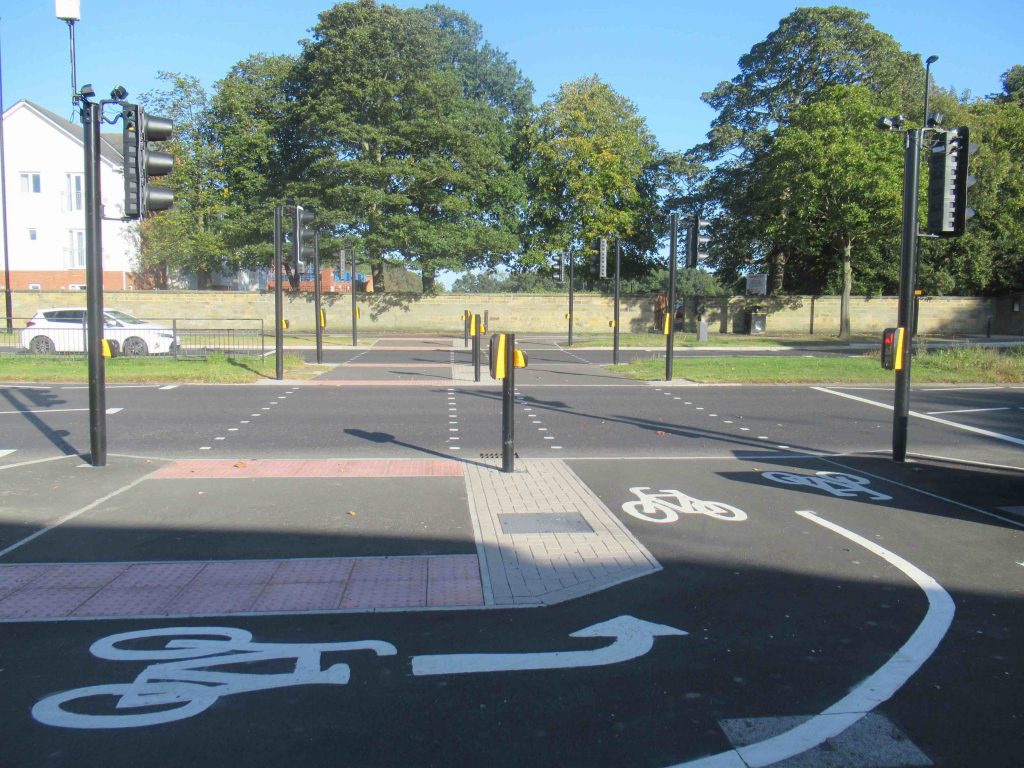
N13 Pedestrian and cycle crossing
Between the crossing and Polwarth Drive the cycle track is two-way to create a direct two-way route between Brunton Park and McCracken Close. If this wasn’t two way, people from Brunton Park would have to cycle north to the next set of lights past the entrance to Melton Park, crossing there then returning south to McCracken Close.
At the bus stop, there is plenty of space for people to alight from or wait for their bus well away from the cycle lane.
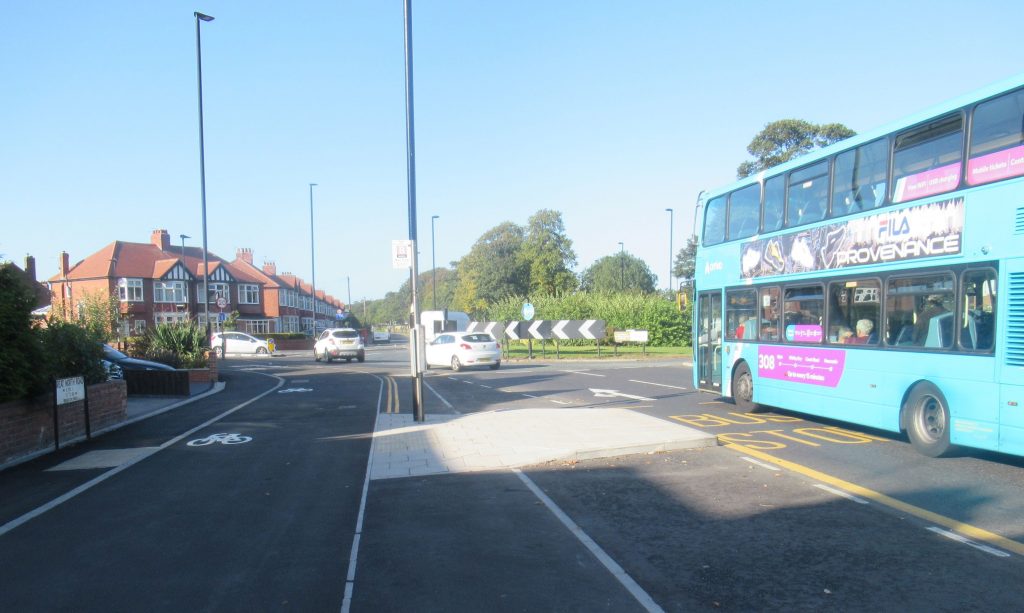
N14 Bus stop next to Polwarth Drive
The crossing at Polwarth is similar to the crossings on Broadway East and West but with a few differences. The first is that the only marked route is straight on across the crossing, whereas at Broadway roundabout it is possible to turn left without crossing the main road.
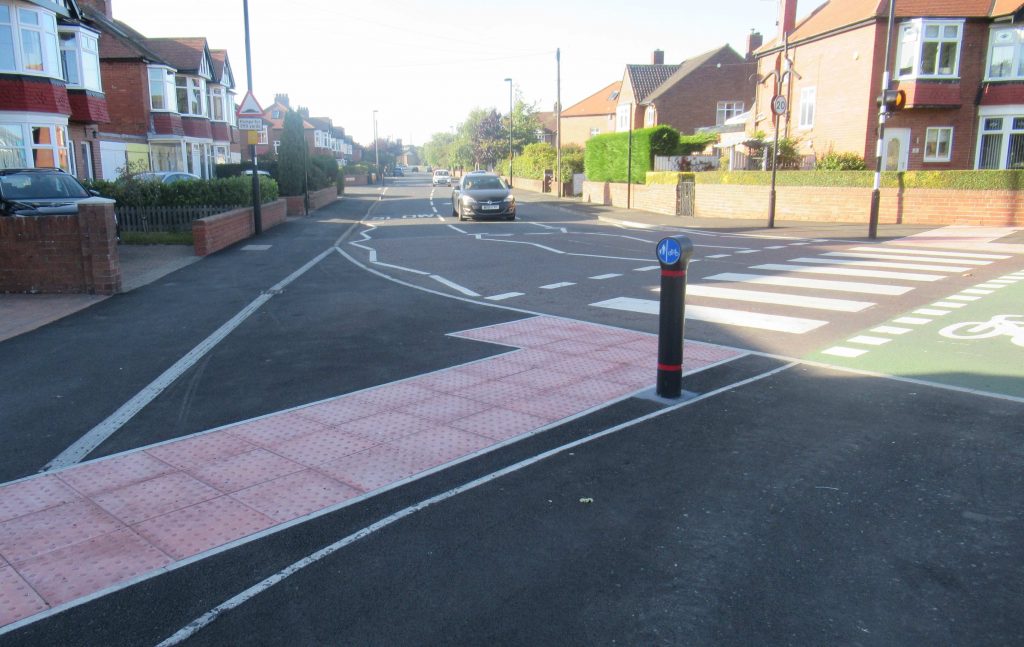
N15 Crossing Polwarth Drive
The second difference is that the crossing is not as wide as at Broadway which, along with the tighter turns on entry, does make the crossing a little more comfortable especially for people on foot. If there had been one exit lane to the roundabout, as was originally proposed, it might have been possible to make this narrower still or have a central island for people crossing on foot.
The Council revised this plan, to create two vehicle lanes exiting Brunton Park at the request of some Brunton Park residents following a meeting about trees and the stone bus shelters. As we said in our analysis of the proposed (Horrible) Haddricks Mill junction, according to the US Department of Transportation, “flaring the entry width from one to two lanes is likely to increase injury crashes by 25 percent”.
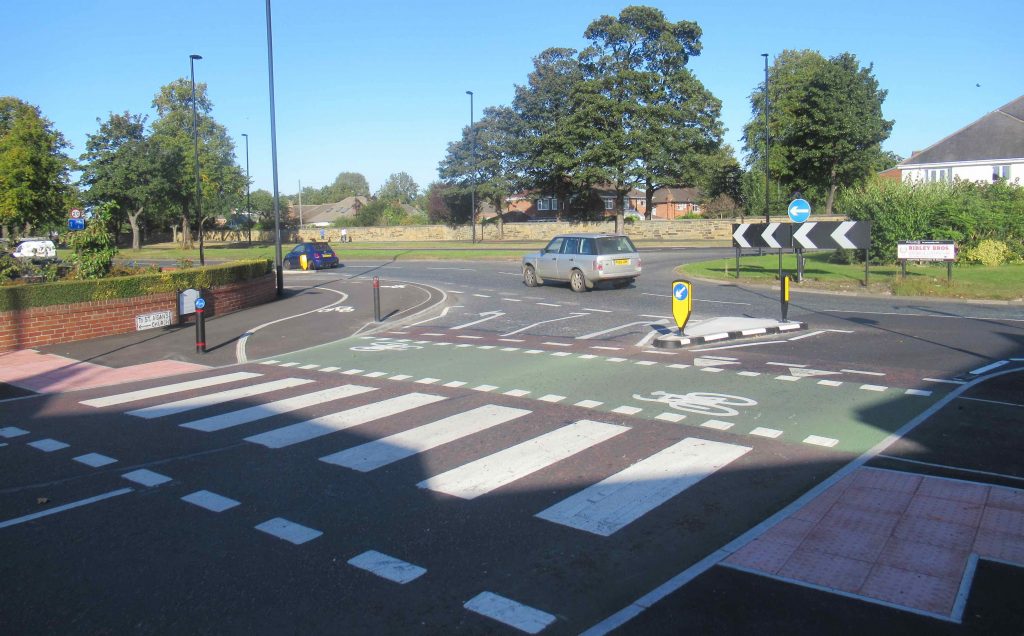
N16 Crossing Polwarth Drive
The design for the entry to the Great North Road service road was also revised. Vehicles can still enter but the entrance has been narrowed and a gentle speed hump added to discourage higher driving speeds.
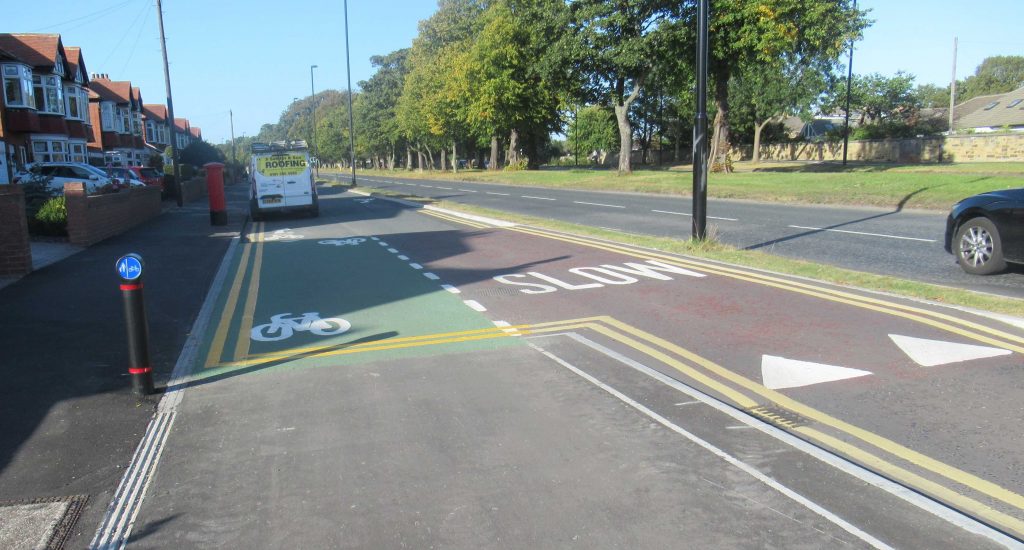
N17 The Great North Road service road entrance
The rest of the route up to Brunton Lane is on the service road, which has very little traffic. The only changes on this section are the addition of painted cycle signs on the road and the priority at the entrance to Norwood Avenue has been changed so vehicles entering from Norwood Avenue have to slow down and give way.
At the very north end of the route is Gosforth’s original ‘bus stop bypass’ only rather than being bypassed by just a cycle lane it has a whole road going behind it.
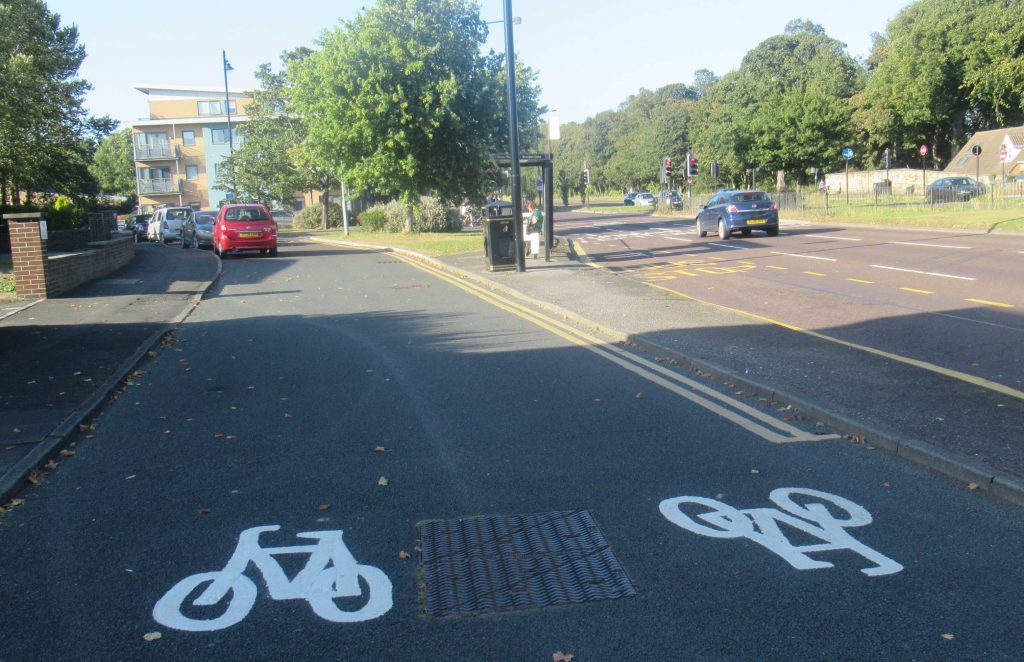
N21 Bus stop bypass by Brunton Lane
The crossing you can just see on the right in the above photo was also due to be updated as part of the scheme to remove the large dog-leg in the middle. This, we understand, is due to be included in a future scheme connecting Brunton Lane with Gosforth Park and Wideopen.
Route Review – South Bound
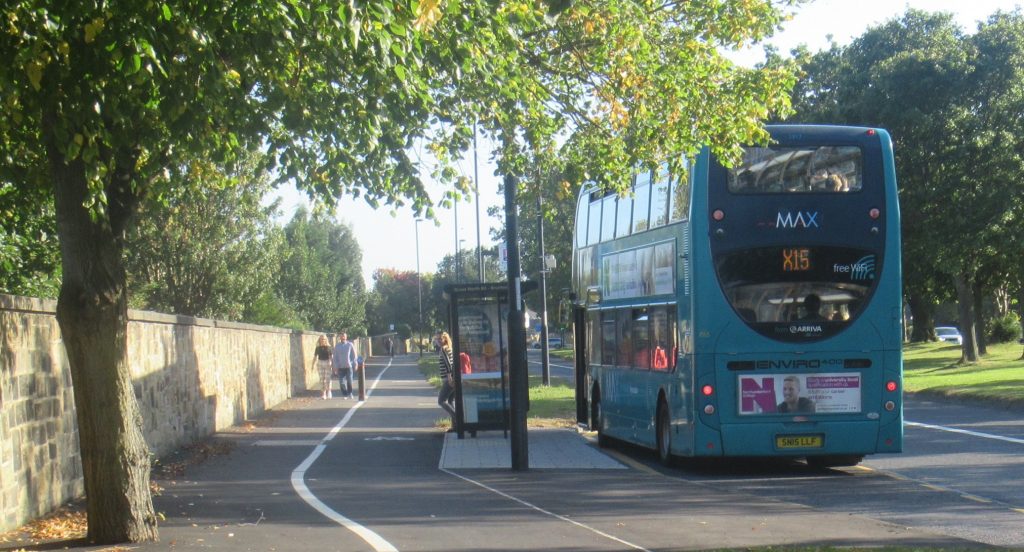
S1 Bus stop opposite Brunton Lane
Starting again at the north end of the route going south, the first thing you would come across is a new bus stop bypass where the cycle lane passes behind the bus stop. This shelter has glass walls to give some protection from the wind but also to allow people at the bus stop to see oncoming buses and people cycling. There is also tactile paving to show guide people with a visual impairment where to cross the cycle lane.
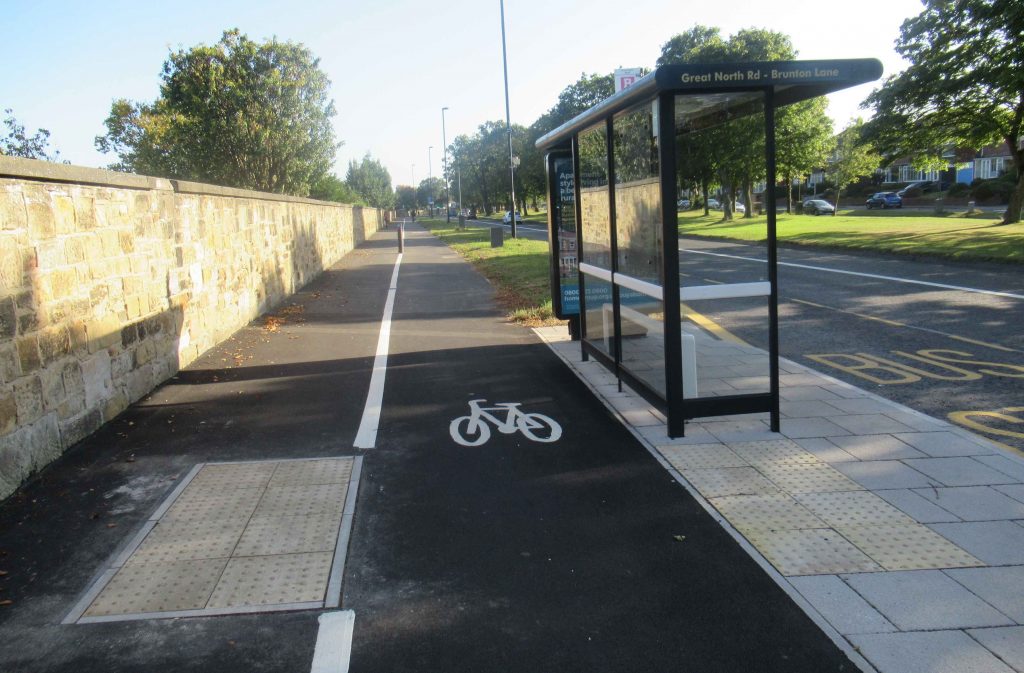
S2 Showing tactile paving to cross the cycle lane
South of the bus stop the Council have planted somewhere between twenty five and thirty new trees on the grass verge and in the central reservation, replacing removed trees by a factor of about 5:1. These were added as part of the cycle scheme. Details of the tree removal and re-planting can be found here.
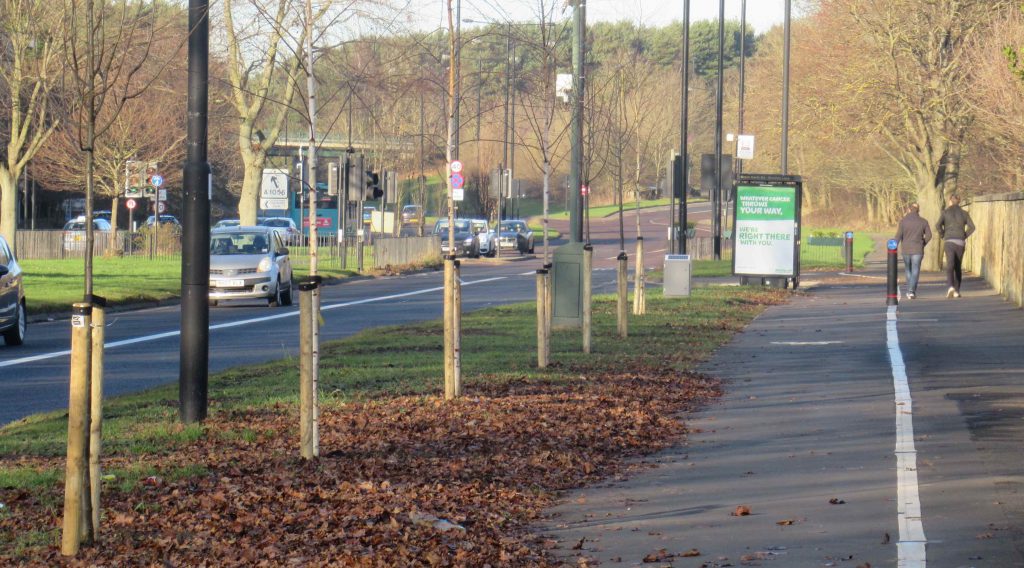
S3 Newly planted trees next to the cycle lane
At the next bus stop the cycle lane goes in front of the bus shelter.
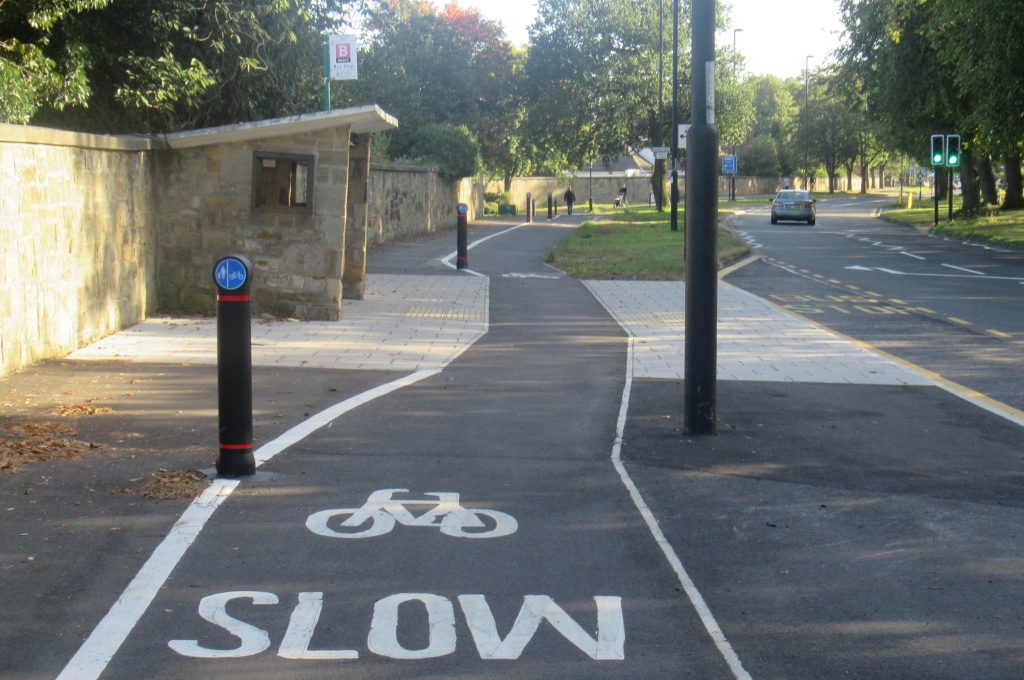
S4 The cycle path passes in front of the stone bus shelter
This is a fairly common arrangement in the Netherlands at locations where space is limited. The picture below shows a bus stop from Haarlem. The main difference between the two locations is that people waiting at the Harleem bus stop can see much more clearly what is coming. They can also sit down while waiting.
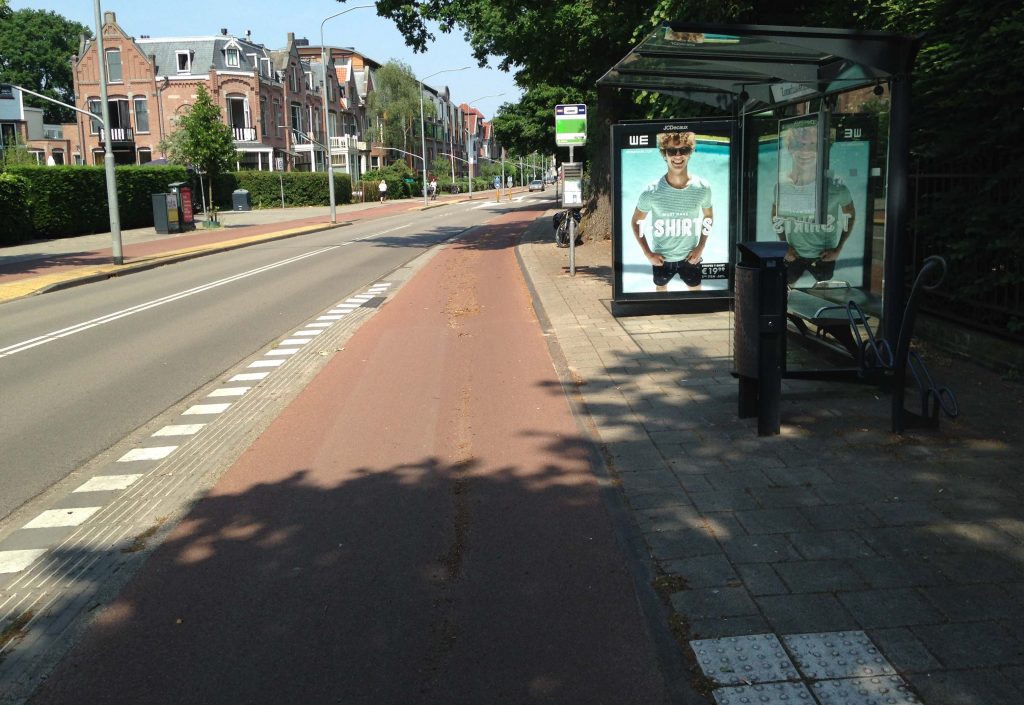
Bus stop and cycle lane in Haarlem, Netherlands
Both at Haarlem and on the Great North Road there is tactile paving to show where to cross the cycle lane.
This design, has mitigated some of the concerns we raised about retaining the Stone bus shelters.
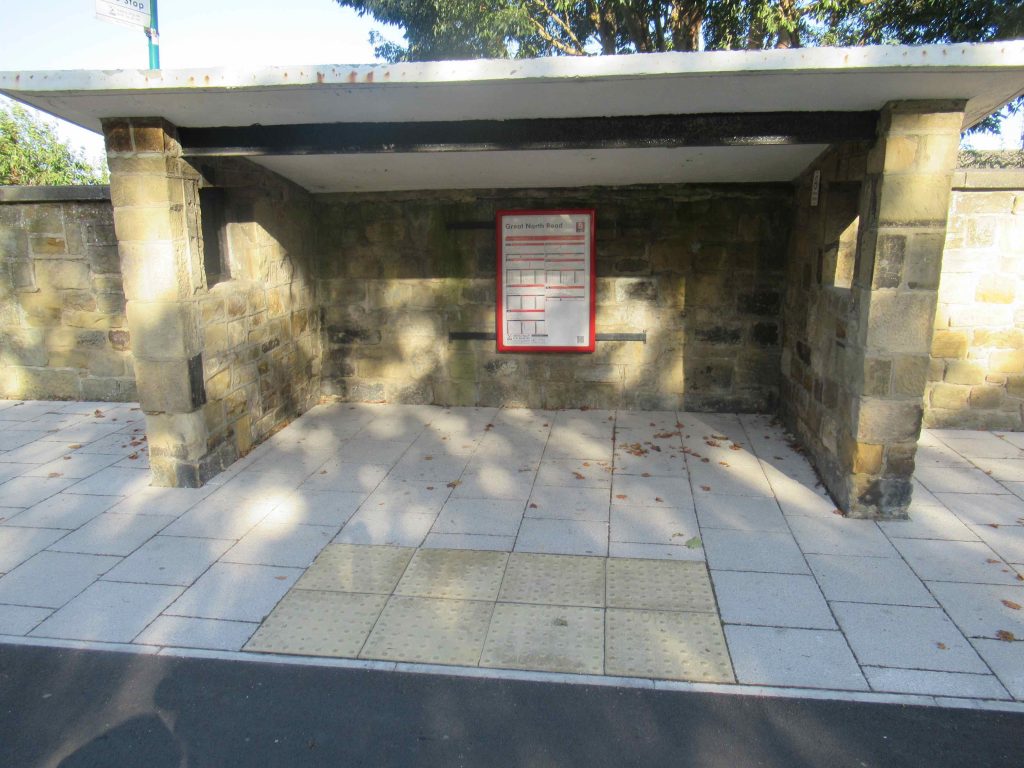
S5 Stone bus shelter and tactile paving
Where the cycle route meets the crossing just north of Newlands Avenue the route briefly becomes a shared space for walking and cycling. We think a design more like the parallel crossing south of Polwarth Drive, with a continuous cycle lane and separate tactile to cross the cycle lane and the road, would have made more sense at this location for people walking and cycling but it isn’t a big issue.
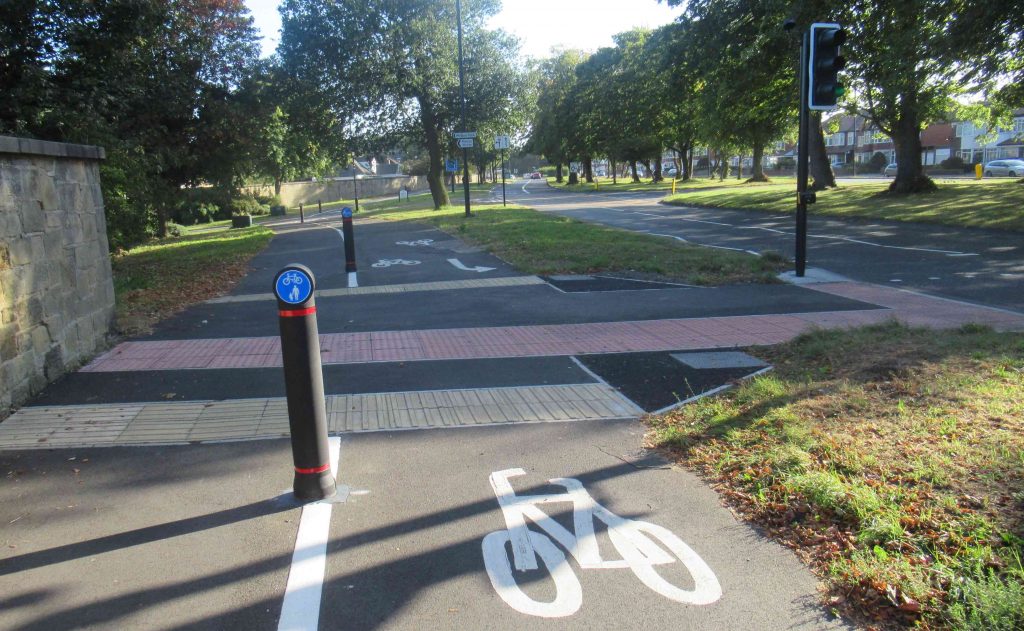
S6 New toucan crossing just north of Newlands Avenue
Between the crossing and Newlands Avenue the route briefly becomes two-way to make it easier for people exiting Newlands Avenue wanting to travel north, rather than having to travel to the crossing south of Polwarth Drive and back again.
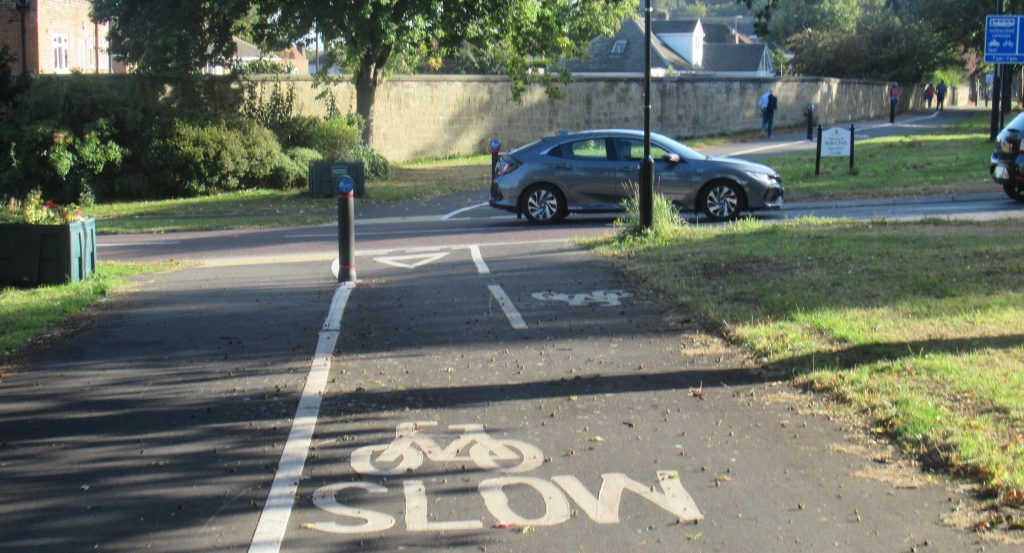
S7 Approaching Newlands Avenue
At Newlands Avenue, the side road has priority over people travelling along the main road. There doesn’t appear to be any rational reason for this road to be different from all of the other side road junctions along the route. The main effect will be that people who are comfortable cycling in the bus lane will be encouraged to continue to do so. If Newlands Avenue is really that busy the Council might consider a zebra crossing for people walking north-south.
By the roundabout, the path has been widened and the railings have been removed. While railings have been used widely across the country in the past, evidence now suggests they have no real benefit for safety. Transport for London, in its Streetscape Guidance, says “there is no conclusive evidence that the inclusion of PGR [Pedestrian Guard Railings] at any type of pedestrian crossing or junction has any statistically significant effect on the safety record“.
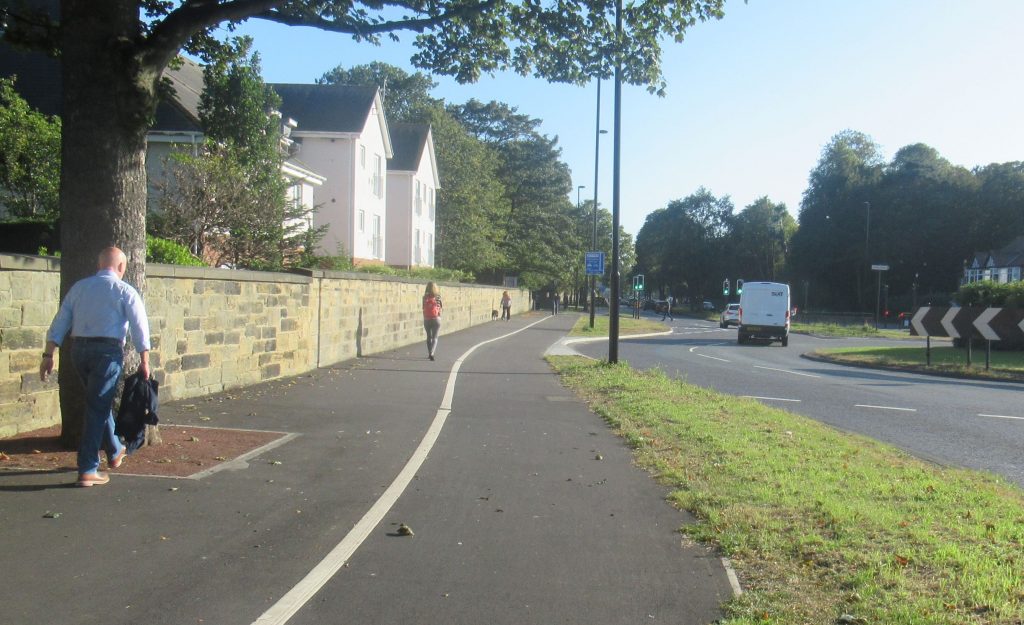
S8 Opposite Polwarth Drive
At the crossing south of the roundabout, the layout is similar to the other side. It does look from the picture below that the tactile paving on the left of the cycle path has been missed. We have informed the Council.
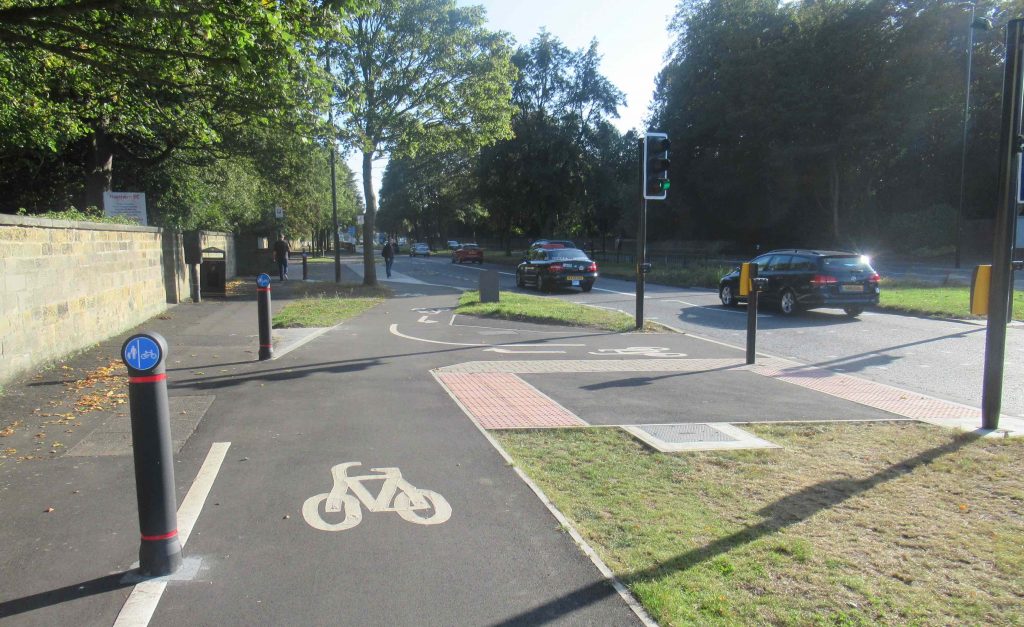
S9 Pedestrian and cycle crossing next to McCracken Close
At McCracken Close priority is again given to people walking and cycling along the main road so vehicles exiting from the side road have to give way.
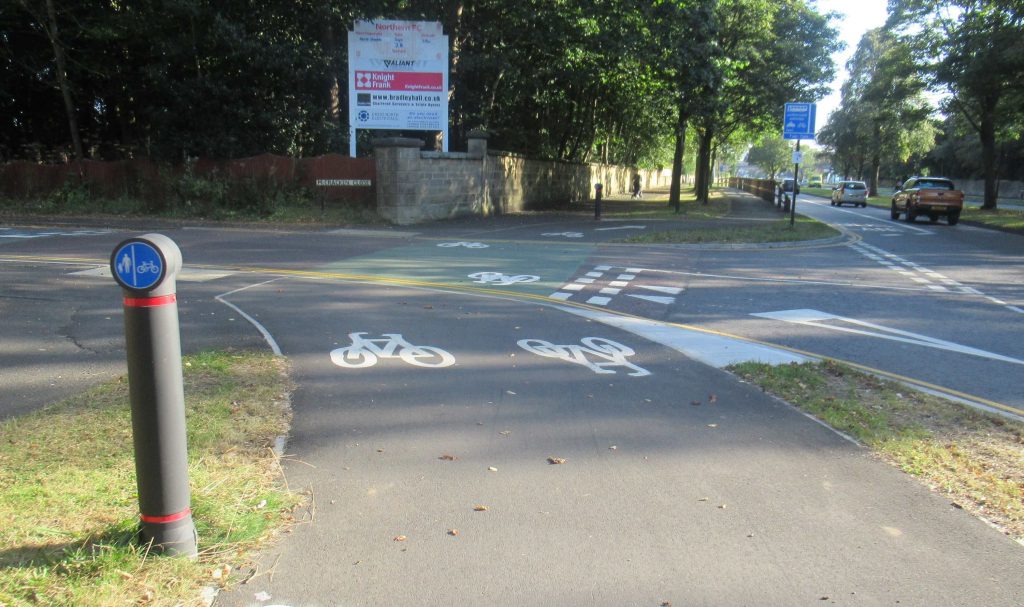
S10 McCracken Close
After McCracken Close, the cycle path becomes separate from the pavement and, as it is slightly higher than the road, fencing has been installed. Part of the reason for the height difference is that tarmac was laid above the existing ground level rather than digging down to avoid damage to tree routes.
We have had feedback from SPACE for Gosforth members that the end of this section where it drops down again to pavement level can be slippy if there is ice or lots of leaves. We have provided feedback separately to the Council about the (lack of) maintenance for walking and cycling paths in winter, which we are told is not currently possible due to budget pressures.
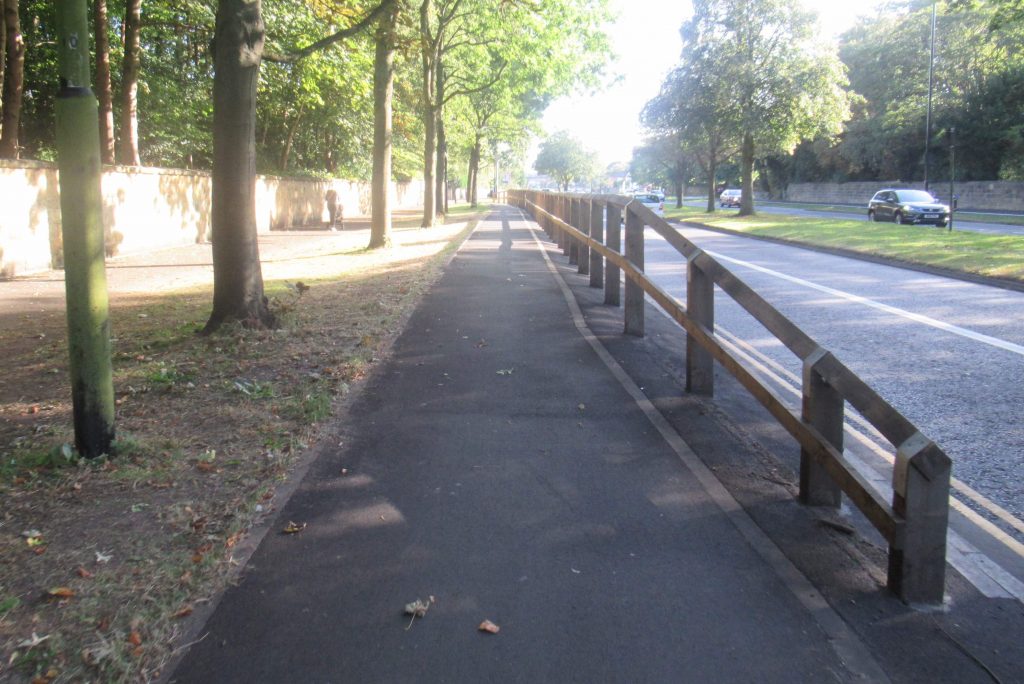
S11 Raised cycle lane south of McCracken Close
At the entrance to Fencer Court, the paths join up again.
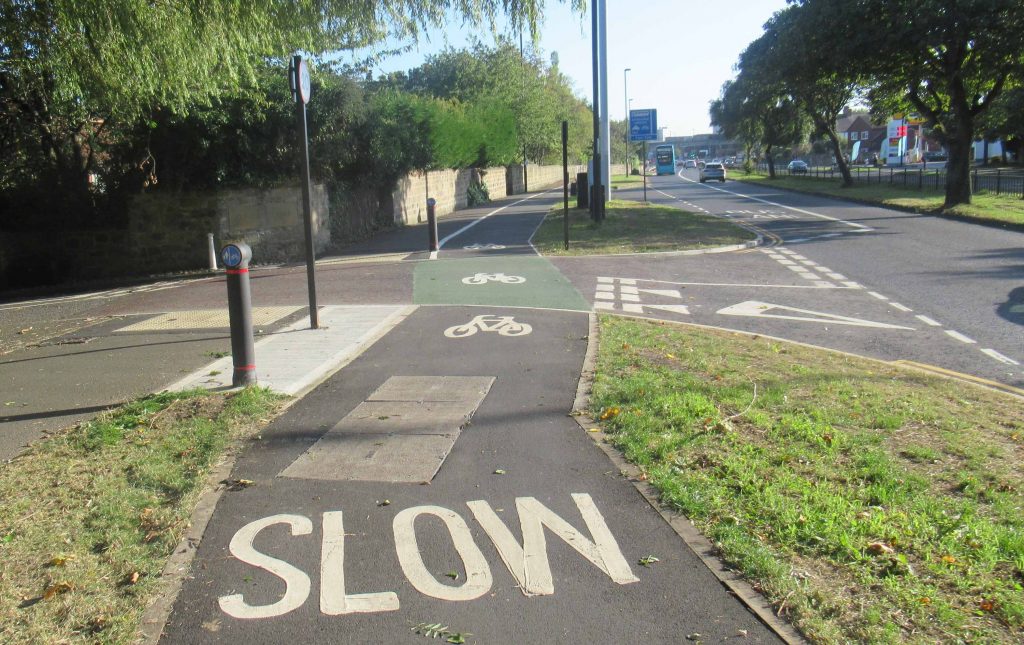
S12 Entrance to Fencer Court
This is followed by a long section with no crossings or driveways. The bollard, one of many along the route, shows that one side should be for walking and one for cycling. In the Dutch example at the top of this blog, bollards like this are not needed because the cycle path is clearly marked in a different colour tarmac. The Dutch approach means less street clutter and fewer hard objects that people might crash into.
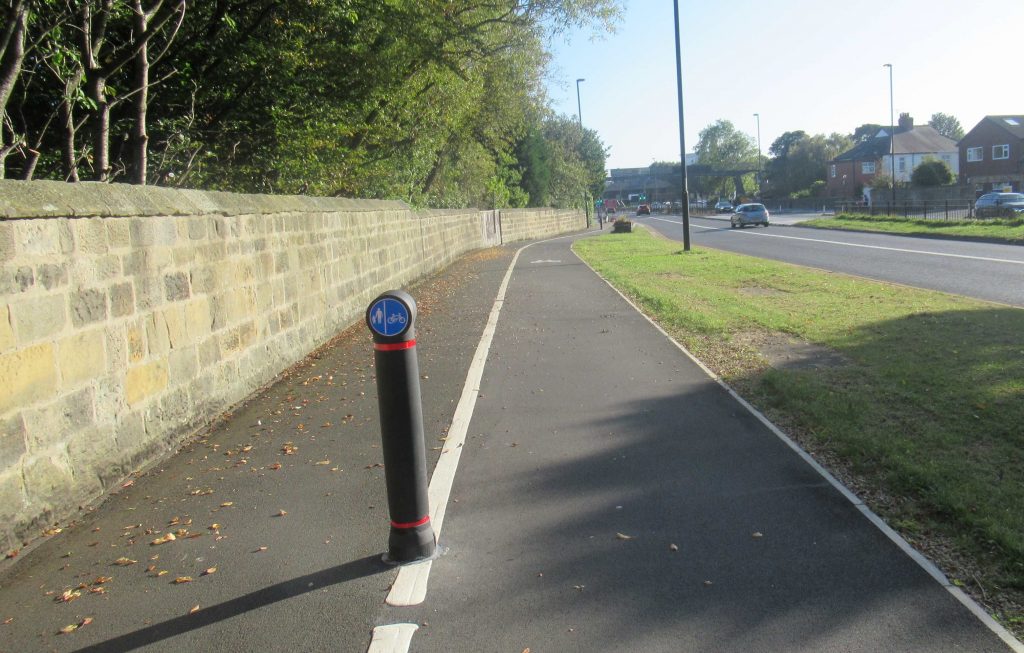
S13 South of Fencer Court
At the bridge over the Ouseburn the motorway-style barrier has been retained, just like on the other side of the road, to protect the bridge from damage from motor vehicles.
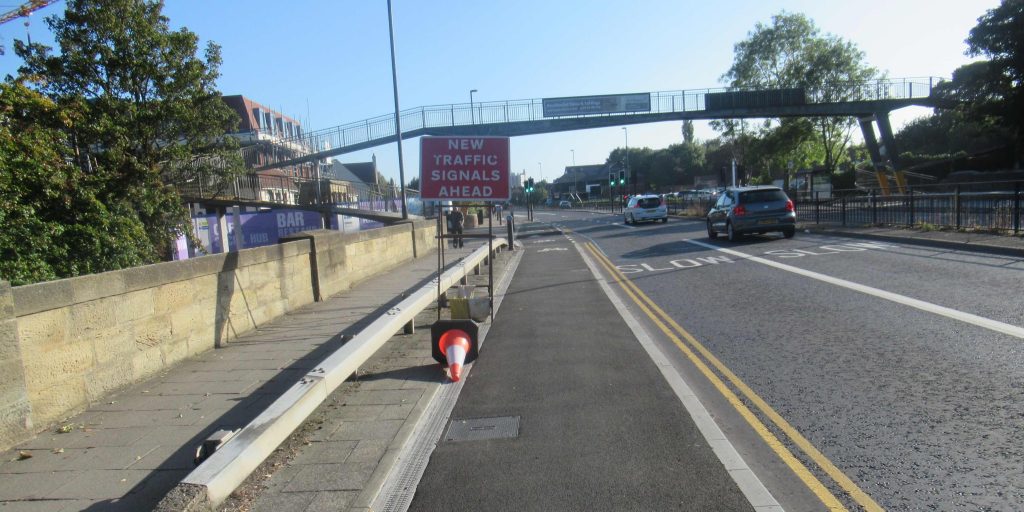
S14 Crossing the Ouseburn
At the crossing by the Three Mile Inn, people cycling can continue without having to stop for the lights. For people on foot, crossing the cycle lane is more akin to crossing one of the many side roads on the route, and probably safer, so lights are not required.
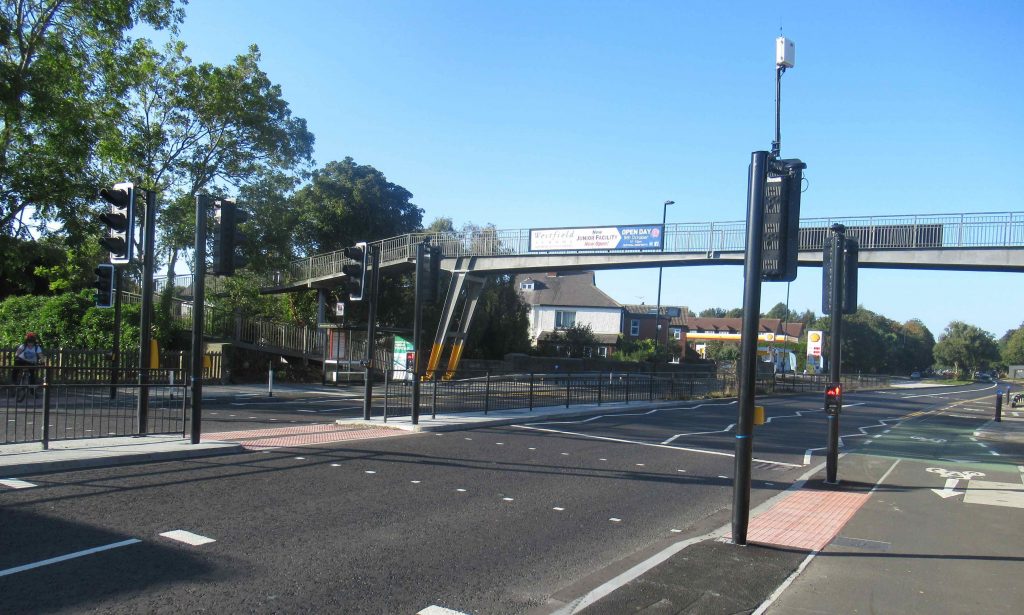
S15 Toucan crossing next to Three Mile Inn
The design of the south-bound bus stop by the Three Mile Inn (below) is much closer to the example we shared from Haarlem above, with the shelter providing shelter and somewhere to sit as well as good visibility north to see oncoming buses and bicycles.
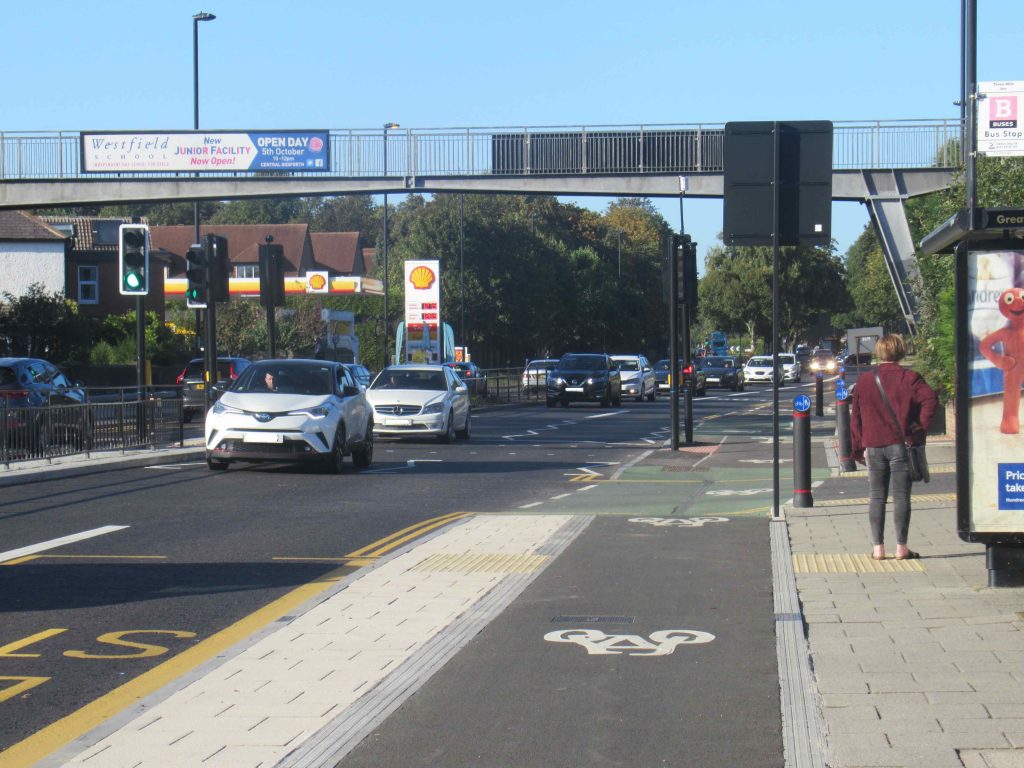
S16 Bus stop south of the Three Mile Inn
Near the end of the route by Broadway roundabout, the cycle track is no longer level and instead drops to road level by each driveway and then back up to pavement level in between. This may cause issues for people cycling who have a disability or are carrying children or heavy luggage. We discuss this issue in our blog Inclusive Cycling – the Good, the Bad and the Ugly. It also makes for quite an uncomfortable experience for anyone travelling at a reasonable speed.
From the picture you can see that this is just replicating the existing line of the pavement. We did ask that the pavement be made level and the cycle path along with it, but were told that the Council have to design to government standards which require a shallow gradient for cars exiting driveways, and that this take priority over people walking, cycling, pushing buggies or people in wheelchairs, all of whom will be affected by this. The Conservative Government did promise in its 2019 election manifesto that they would soon publish new design standards for cycling so we hope this will be resolved as part of the new standards although at the time this blog was published these standards had still not been released.
Newcastle City Council isn’t the only local authority to do this. For example there is quite an extreme example of this in Cheshire that looks even more like a BMX track than a pavement and cycle lane.
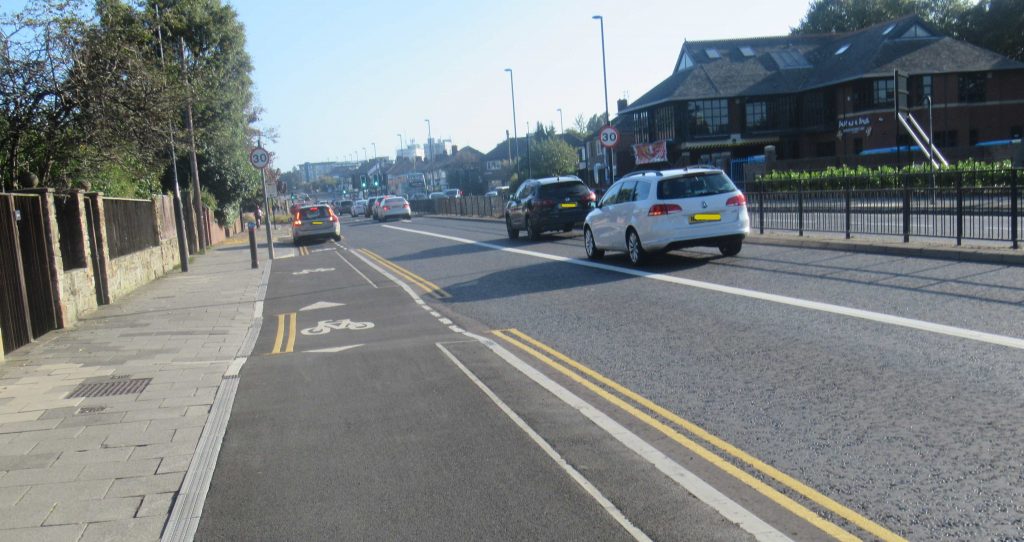
S17 Approaching the Broadway Roundabout
The car in the distance on the picture above is a local resident who has pulled briefly onto the cycle lane out of the way of moving traffic before reversing into their drive. This means when they are exiting their drive they are facing forward and can see oncoming traffic as well as people walking and cycling.
There are issues with vehicles being parked on the pavement and cycle lane along this section of the Great North Road but this was not one of them.
Rather disappointingly, the final short section of the route is at road level and becomes an advisory cycle lane only separated from the main carriageway by a painted line. Because of the lack of separation, some people cycling might choose to use the pavement for a short distance.
A better solution would have been to install bolt-down kerbs like on the north-bound lane. Installing bolt-down kerbs along this section would also have allowed the route to stay level with the carriageway rather than going up and down. The vehicle lanes at this point are still quite wide, and might even benefit from being narrowed to reduce speeds in the approach to the roundabout, so there is space to do this.
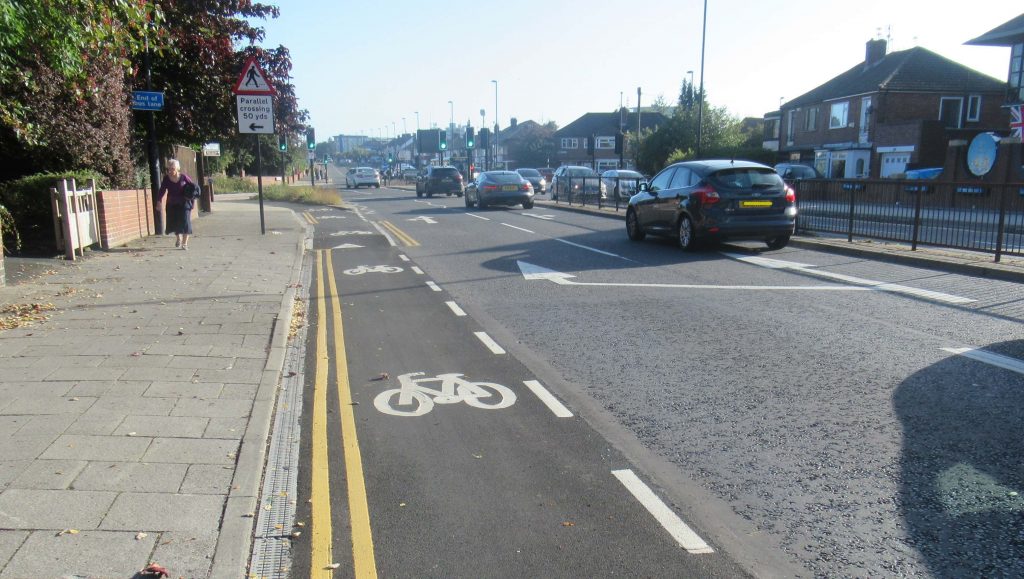
S18 Approaching the Broadway Roundabout
Research into child cycling has shown that parents quite reasonably do not regard paint-separated lanes to be suitable for child cycling and our experience in Gosforth is that cars regularly encroach on painted cycle lanes. As this stretch is likely to be used by school children, we hope the Council will fix this and provide safe onward connectivity to local schools including Broadway East and Gosforth Park First Schools, Gosforth East Middle School and St. Oswald’s RC Primary School.
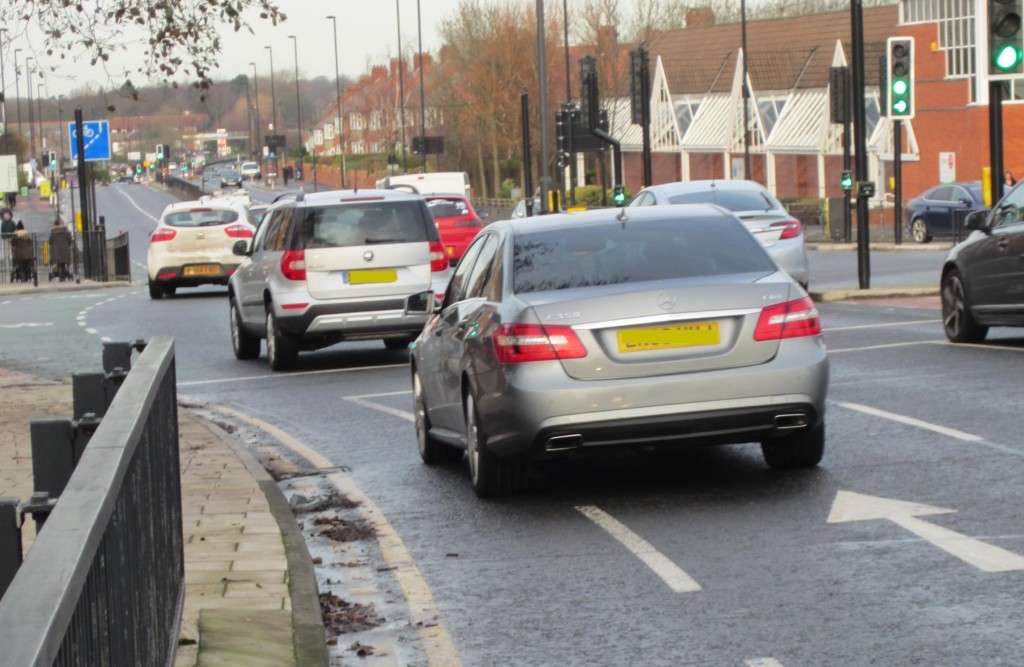
A car encroaches in the cycle lane at Regent Centre traffic lights
Overall, as we said at the start, this is definitely a step in the right direction. Prior to this route being installed, cycling along this section of road felt very dangerous, and the extra crossings will help people walking local journeys. Even just using this a few times it is obvious there are more people out cycling than there were previously, including unaccompanied older children.
The key lessons we think for the Council in planning future main-road routes are:
- Ensuring designs are inclusive, so that they enable a wider range of people to cycle, including people with disabilities, parents with children and existing cyclists. That includes ensuring sufficient width so a parent and child can cycle together.
- Setting standards for cycle lanes e.g. green tarmac, so that the number of bollards can be minimised, and a design speed. Government guidance suggests that cycle lanes should be designed to allow someone cycling to do so at 20mph even if the average speed is more likely to be closer to 12mph.
- Coming up with a design for continuous pavement and cycle lanes across side roads, much like in the Dutch examples, to maintain main-road priority. People cycling shouldn’t have to slow down at side junctions any more than someone who is driving a car along a main road.
- Making sure pavements and cycle lanes stay at a level rather than going up and down at driveways.
- Implementing at pace. If this had been implemented immediately after the original consultation we would have benefited from the new cycle lane and crossings for three additional years at no extra cost.
The Council also, more recently, mentions its investment in cycling as a way of combatting Climate Change. We don’t think this scheme will make much difference to carbon emissions because it has not included any changes that would reduce or slow traffic along the Great North Road. At the time of the consultation this was presented as a good thing, however if the Council is now serious in addressing Climate Change and removing vehicle lanes might be possible, the extra space freed up would almost certainly make it easier to design a high quality route.

For comparison, here is an explanation of how a typical main road / minor road junction works in the Netherlands, taken from the BicycleDutch blog A common urban intersection in the Netherlands.
Both the Dutch and local junctions have raised humps, give way markings and space for a vehicle to wait off the main carriageway. The main difference is that in the Netherlands the cycle route has a continuous surface so it is much clearer that it continues through the junction.
Another common approach seen here on Biltstraat, a local shopping street in Utrecht, is to have a continuous pavement as well so it is absolutely clear that people walking and cycling on the main road have priority over traffic on the minor road. This is similar to our proposal for Pedestrian Priority on Gosforth High Street, which the Council consulted on but never implemented.
This fairly average street in Ijmuiden in the Netherlands (below) has a clearly marked, level straight-line route, which gives much greater separation from traffic and continues through side junctions giving people walking and cycling priority over turning vehicles.
Here is another example, of a more suburban street like the Great North Road with a central reservation with trees, bus stop and side road entrance.

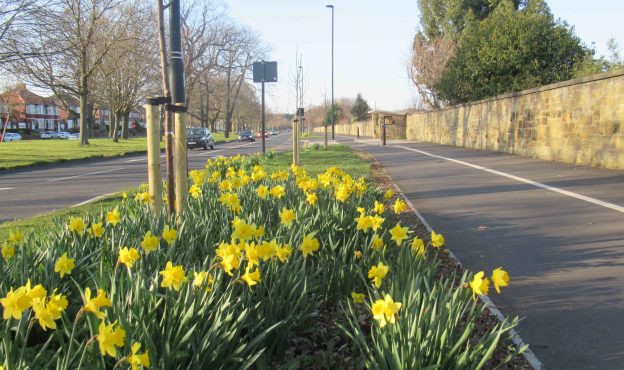
It’s been hugely encouraging to see so many families using the lanes during lockdown. They are also noticeably busy during school run times, so much so that an experienced cyclists will avoid them in order to make progress.
I don’t believe there is adequate signage at McCracken Park, motorists are not slowing as the enter or exit. Indeed, many seem to think that entrance can be achieved on just two of their four wheels.
I also think there should be more speed limit signage on this stretch. Many motorists are clearly well over the limit and when darker and damper days return this will present a greater danger to those using the cycle and pedestrian lanes.